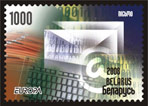The Importance of Corporate Email Etiquette
 How many times a day is your company making a marketing statement via email? Well, how many emails does your company send in a day?
How many times a day is your company making a marketing statement via email? Well, how many emails does your company send in a day?
Every email from every person in your company reflects directly on your business. Email is probably your largest area of exposure to your customers…
There are three awfully good reasons to take time for proper email etiquette in your organization:
Professionalism: Proper email language and rules for your company will convey a professional image.
Efficiency: Emails that get to the point are much more effective than long-winded or poorly worded emails.
Liability: Emails are company documents. Company-wide awareness of email risks will protect your company from costly law suits.
Top Ten Corporate Email Rules
We have developed a list of 23 vital business email rules; download it here in PDF.
We include the Top Ten email rules here, though:
1 – Answer swiftly
Your customers send you e-mails because they want quick responses. The golden rule for email is to reply within 24 hours, and preferably within the same working day. If your response email is complicated, just send an email confirming receipt and letting them know that you will get back to them, maybe indicating when. This will ease the customer’s mind!
2 – Use a meaningful subject line
Try to use a subject that is meaningful to the recipient as well as yourself. For instance, when you send an email about a product, it is better to mention the actual name of the product, e.g. ‘Product A information’ than to just say ‘product information’. It also makes it easier to search for old emails when the subject line is relevant.
3 – “Reply to all”
Only use Reply to All if you really need your message to be seen by each person who received the original message. However, if communication is vital between all parties in an email thread, use the Reply to All to keep everyone in the loop. If you only use Reply in such a case, the recipient may have to forward your email to everyone else, which is frustrating and disjointed.
4 – Use the Bcc:field
When sending to many people, some people put all the email addresses in the To: or CC: fields. There are two drawbacks to doing that: (1) the recipient knows that you have sent the same message to a large number of recipients, and (2) you are publicizing someone else’s email address without their permission. Instead, consider using the Bcc: field. Put your mailing list group name in To: field (or your own email address; leaving the To:field blank may look like spam). If you have Microsoft Outlook and Word you can do a mail merge so each recipient receives their own email.
5 – Don’t leave out the message thread
Include the original mail in your reply, in other words click ‘Reply’, instead of ‘New Mail’. We all receive many emails and we can’t always remember the details of each individual email. Leaving the thread may take a fraction longer in download time, but it saves the recipient time looking for the related emails in their inbox.
6 – Read your email!
Treat email like any other official company document! Read it before you send it. Spelling and grammar errors are just as unfortunate in email as anywhere else in your corporate correspondence. Look out for potential misunderstandings and inappropriate comments -we use email because it is quick and easy but precisely that quickness may cause more trouble than you bargained for!
7 – Confidential information
Email is just too risky a place to include confidential information. Ask yourself if you want the content of your email displayed on a bulletin board. Never make libelous, sexist or racially discriminating comments in emails, even as a joke. Consider implementing a Disclaimer on the bottom of all corporate emails with statements on Breach of Confidentiality, Virus Liability, etc. (Yes, you can be sued for sending an email that contains a virus!)
8 – Abbreviations/Emoticons
Be careful using email abbreviations such as BTW (by the way) and LOL (laugh out loud) in business emails. Even today, some people still don’t know what they mean, so it’s better to drop them. And emoticons, such as the smiley 🙂 don’t belong in business email unless a relaxed form of communication has long been established with the customer.
9 – Don’t attach unnecessary files
Wherever possible try to compress attachments and only send attachments when they are productive. Make sure you have good virus software in place to scan your outgoing emails – a customer would not be happy if you sent them documents riddled with viruses!
10 – Don’t forward junk!
Don’t forward chain letters, virus hoaxes, chain email solicitations for charitable causes even if they sound bona fide, funny pictures and jokes. Would you put these things on your corporate letterhead? I don’t think so. Don’t ever send or forward emails containing libelous, defamatory, offensive, racist or obscene remarks and jokes. Just one offensive remark can result in a multimillion dollar court case for you and your company.
Need help developing an Email Policy?
Consider hiring us to write your policy for you. We’ll customize our efforts to fit your business environment and make sure you cover all angles of professional email procedures!
 SEO Lakeland FL Web Design Lakeland FL
SEO Lakeland FL Web Design Lakeland FL